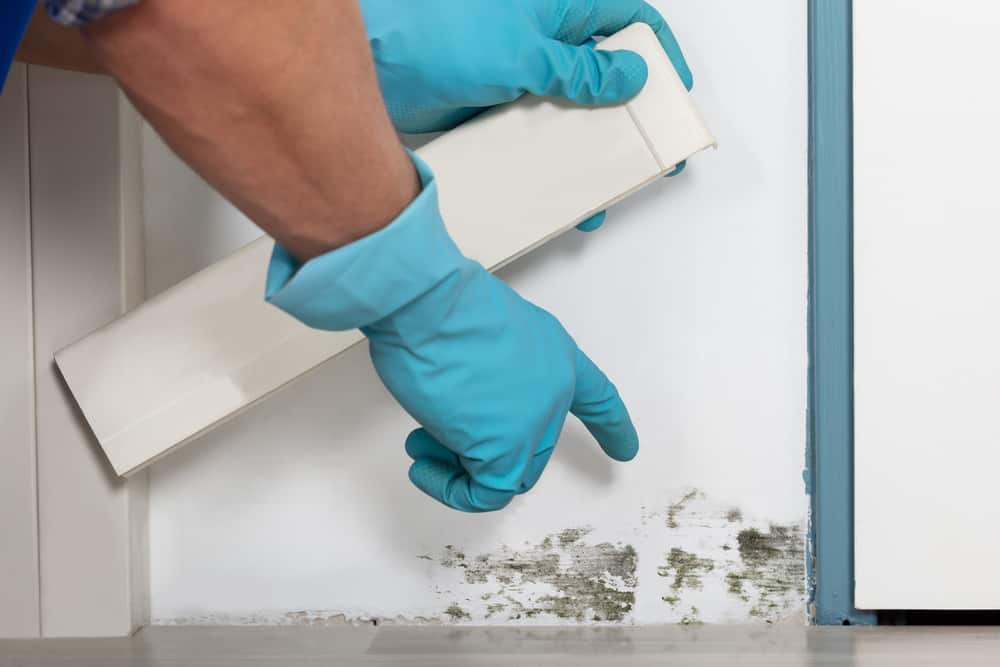Almost every home has a baseboard because of the aesthetic look it offers. But can it also cause mold in our valuable property? Unfortunately, mold can be difficult to detect in a home, especially in hidden areas. And baseboard is one of the hidden spaces for mold growth. Mold growth behind baseboards caused by water leakage is also a bother when it affects the attractiveness of your wall.
Water damage can build due to leakage from the roof, window, air conditioning, etc. In addition, when leakage occurs behind the baseboard, it takes an extended time to dry, causing mold to spread and form on the wall behind the baseboard and the baseboard itself. Therefore, what should a homeowner do if mold begins to grow under the baseboard? But, before we answer that questions, let’s first look at how to understand the mold present in your home’s baseboard.

Understanding Molds Behind Baseboards
The mold behind the baseboard is unnoticeable. However, the time it takes for mold to grow is a factor in this problem. Mold can grow in the back of the baseboards for a long time, making it hard to see. Mold behind baseboards is not always a significant health hazard, but it can be. The mold did not release spores into the airstream because it contained microbial development behind the baseboard—causes of mold growth, including factors of moisture, high temperatures, and mold spores.
Remove the Unnoticed Mold in Baseboards
Baseboards are made of wood and can quickly become wet. As a result, mold can multiply in size quickly. As they spread, it indicates that water damage is infiltrating the house. Mold prefers to grow on wood because it can retain much moisture. In this situation, mold removal is necessary.
Mold removal from baseboards may require complete removal and replacement to restore the home’s aesthetic appearance. The baseboards can be cleaned with soap and water by homeowners. However, if the mold grows behind the baseboard, it must be carefully removed, cleaned, and disinfected.
Effective Mold Removal
It is advisable to call your local mold removal company to assist you. But, if you want to get rid of the mold in your baseboards on your own, these are the standard procedures you should follow.
The first step is to wear protective gear. It is critical to use appropriate protection to avoid getting sick due to mold exposure. Protective eyewear, a face mask covering your nose and mouth, and rubber gloves are all advised measures when cleaning.
The next step is to vacuum the area. It is critical to use a vacuum equipped with a HEPA filter to remove any mold spores stored in the wood and the other areas. Vacuum the area thoroughly, and then take the vacuum outdoors to empty it. Assure that the vacuumed material is correctly sealed in a plastic bag to prevent the escape of spores during the cleaning process.
After the vacuum clean-up, remove the mold with dishwashing soap and warm water; you can clean everything. Use a spray bottle filled with water and add a teaspoon of soap. Then gently scrub the mold using a soft-bristled brush, sponging up any extra liquid as you clean. And then, ensure to dry the surface of the baseboards with a towel.
If soap and warm water can’t remove the mold, you may use distilled white vinegar. It kills more than 75% of mold species. You can add vinegar and warm water to a spray bottle. Spray this mixture on the mold, let the solution dry for an hour, then wipe the surface with a wet cloth and a dry towel.
If mold remains, apply Borax. It is a non-bleach alkaline mineral salt cleanser. With a soft-bristled brush, apply a cup of water and a tablespoon of Borax to the mold. Begin by scrubbing away the mold, leaving the Borax in the wood. Then, absorb any excess liquid. Preserve as much of the solution as possible in the wood. Next, rapidly and thoroughly dry the wood with a fan or dehumidifier, leaving the Borax beneath the surface. While the mold may be gone, it will undoubtedly recur within a few months. Finally, you may use 100-grit sandpaper to remove scratches and traces.
Tips:
Mold removal experts do not advise using bleach to kill mold on wood. While bleach is effective on non-porous surfaces, it is ineffective on wood. Additionally, because chlorine cannot enter the wood, only the water component of bleach is absorbed.
It would be best to use a moisture meter to ensure that all water has been thoroughly dried, providing that no mold can grow. You might call a plumber or a leak detecting company to check for leaks.
The best way to stop mold from growing is to remove all sources of moisture. For example, before treating decay on a wet wall caused by a leak, you must fix the leak first.
The moisture problem was not adequately dealt with if mold grows back and will need to treat again. If you performed the mitigation yourself the first time, get a professional this time. This way, you can ensure that everything is correct and completed.
Final Say
While removing the mold is crucial, it must also address the root cause. Therefore, it is vital to evaluate the source of the water damage that caused the mold development in the baseboard. Regular inspections of windows, roofs and other sources of water leaks are beneficial for avoiding a recurrence of this situation in the future. Remember, repairing the leak must first be done before installing new walls or baseboards.
Super Star Restoration is your best option if you want a professional to handle your mold removal and water damage restoration. They are professionals, skilled, and the ideal team for your home remediation. Furthermore, they provide an effective solution to your home needs such as Sewage Damage Cleanup, Wet Basement, Crawl Space, and many others. Super Star Restoration is your best home remedy in Rocklin, CA.

